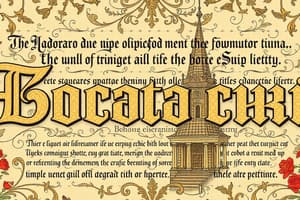Podcast
Questions and Answers
What is the Cyrillic script?
What is the Cyrillic script?
- A language spoken in Eastern Europe
- A writing system used for various languages across Eurasia (correct)
- A form of calligraphy used in Russia
- A religious text used in the Eastern Orthodox Church
Who is the Cyrillic script named after?
Who is the Cyrillic script named after?
- None of the above
- Saint Cyril (correct)
- Tsar Simeon I the Great
- Saint Methodius
What is the Early Cyrillic alphabet?
What is the Early Cyrillic alphabet?
- None of the above
- A variation of the Glagolitic script (correct)
- The first version of the Cyrillic script developed during the reign of Tsar Simeon I the Great
- A script developed by Saint Cyril and Saint Methodius
What is the lingua franca of the Balkans and Eastern Europe?
What is the lingua franca of the Balkans and Eastern Europe?
What is the relationship between Cyrillic and Latin typography?
What is the relationship between Cyrillic and Latin typography?
What is the official script of Serbia's administration?
What is the official script of Serbia's administration?
What are the different systems for Romanization of Cyrillic text?
What are the different systems for Romanization of Cyrillic text?
What is the name for representing other writing systems with Cyrillic letters?
What is the name for representing other writing systems with Cyrillic letters?
What is the difference between Cyrillic and Latin keyboard layouts?
What is the difference between Cyrillic and Latin keyboard layouts?
Flashcards
Cyrillic Script
Cyrillic Script
A writing system used across Eurasia for various languages.
Origin of Cyrillic
Origin of Cyrillic
Developed in the First Bulgarian Empire, named after Saint Cyril.
Cyrillic in the EU
Cyrillic in the EU
Became the third official script of the European Union on January 1, 2007.
Spread of Cyrillic
Spread of Cyrillic
Signup and view all the flashcards
Cyrillization
Cyrillization
Signup and view all the flashcards
Romanization of Cyrillic
Romanization of Cyrillic
Signup and view all the flashcards
Unicode
Unicode
Signup and view all the flashcards
Variations of Cyrillic Script
Variations of Cyrillic Script
Signup and view all the flashcards
Cyrillic Script in Serbia
Cyrillic Script in Serbia
Signup and view all the flashcards
Study Notes
The Cyrillic script is a writing system used for various languages across Eurasia, with around 250 million people in Eurasia using Cyrillic as the official script for their national languages. The Early Cyrillic alphabet was developed during the reign of Tsar Simeon I the Great in the First Bulgarian Empire, probably by disciples of the two Byzantine brothers Saint Cyril and Saint Methodius, who had previously created the Glagolitic script. The script is named in honor of Saint Cyril. Cyrillic became the third official script of the European Union, following the Latin and Greek alphabets, with the accession of Bulgaria to the European Union on 1 January 2007. The Cyrillic script spread among other Slavic peoples, as well as among non-Slavic Vlachs. The literature produced in Old Church Slavonic soon spread north from Bulgaria and became the lingua franca of the Balkans and Eastern Europe. Cyrillic adapted to changes in spoken language, developed regional variations to suit the features of national languages, and was subjected to academic reform and political decrees. The Cyrillic script used for the modern Church Slavonic language in Eastern Orthodox and Eastern Catholic rites still resembles early Cyrillic. Some currency signs have derived from Cyrillic letters. The development of Cyrillic typography passed directly from the medieval stage to the late Baroque, without a Renaissance phase as in Western Europe. Cyrillic uppercase and lowercase letter forms are not as differentiated as in Latin typography. Cyrillic fonts, as well as Latin ones, have roman and italic types. Similarly to Latin fonts, italic and cursive types of many Cyrillic letters are very different from their upright roman types. In Bulgarian typography, many lowercase letterforms may more closely resemble the cursive forms on the one hand and Latin glyphs on the other hand.Overview of the Cyrillic Script
- The Cyrillic script is used to write several languages including Russian, Bulgarian, Serbian, and Ukrainian.
- The script was created in the 9th century by two monks, Cyril and Methodius, to write Old Church Slavonic.
- There are different variations of the Cyrillic script, including the Western Bulgarian and Southern Serbian/Macedonian forms.
- Cyrillic has been used for languages in Alaska, Slavic Europe (except for Western Slavic and some Southern Slavic), the Caucasus, the languages of Idel-Ural, Siberia, and the Russian Far East.
- Some languages that use the Cyrillic script have also been written in a Latin alphabet, and some countries have officially transitioned from Cyrillic to Latin, such as Turkmenistan and Azerbaijan.
- Standard Serbian uses both the Cyrillic and Latin scripts, with Cyrillic being nominally the official script of Serbia's administration.
- There are various systems for Romanization of Cyrillic text, including transliteration and transcription.
- Unicode encodes Cyrillic letters, including national and historical alphabets, across several blocks.
- Each language has its own standard keyboard layout for Cyrillic script, but there are also transliterating or phonetic/homophonic keyboard layouts for typists who are more familiar with other layouts.
- When practical Cyrillic keyboard layouts or fonts are unavailable, computer users sometimes use transliteration or look-alike "volapuk" encoding to type in languages that are normally written with the Cyrillic alphabet.
- There are different character encoding systems for Cyrillic, including Unicode and ISO.
- Representing other writing systems with Cyrillic letters is called Cyrillization.
Studying That Suits You
Use AI to generate personalized quizzes and flashcards to suit your learning preferences.




